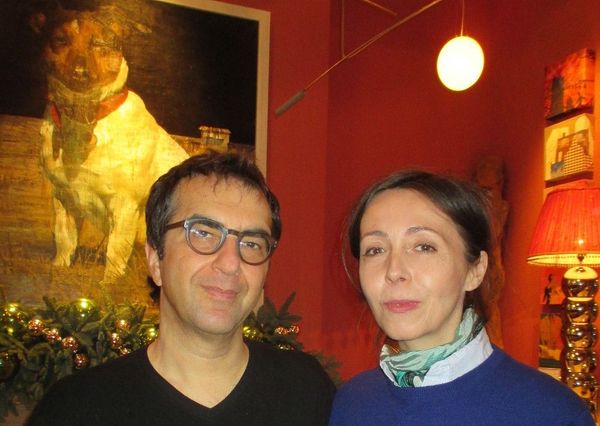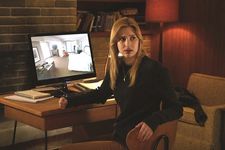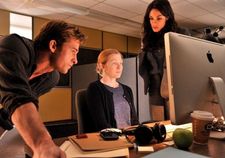 |
| The Captive director Atom Egoyan with Anne-Katrin Titze in New York Photo: Nina Baron |
Atom Egoyan's intense abduction thriller The Captive, starring Ryan Reynolds, Rosario Dawson, Scott Speedman and Mireille Enos with Kevin Durand, Alexia Fast and Bruce Greenwood, takes us to a wintry Niagara Falls and into the clutches of a hellish circle of internet predators. A house straight out of Alfred Hitchcock's North by Northwest turns out to be Marquis de Sade's chateau with Mozart's Magic Flute filling the icy air.
At the Crosby Street Hotel, I started with greetings from Alessandro Nivola, who is starring on Broadway with Bradley Cooper and Patricia Clarkson in The Elephant Man. Atom and I went on to discuss the link to The Sweet Hereafter, fairy tales, Greek mythology, Cornwall and shifting perception, and ended up at Die Walküre and Remember.
 |
| Kevin Durand as Mika: "There's a charge, there's this tremendous sense of vanity that they feel they're operating by this totally different code." |
Christmas decorations were up all around and the painting of a dog on the wall behind us proceeded to morph into Cerberus.
In a modernist woodsy house, a man (Durand) looks out into the snow. From a TV screen we hear the Queen Of The Night. In the basement of this elegant house resides a girl named Cassandra (Fast) who had been abducted eight years ago. She is growing up into a teenager and her usefulness for the pedophile ring has changed. The Captive's structure revolves mainly around three sets of two people with dynamics in flux. Cassandra's mother (Enos) and father (Reynolds) and a team of detectives (Dawson and Speedman) from the Niagara Regional Police collide in their attempts to locate the girl.
Anne-Katrin Titze: First of all, Alessandro Nivola sends his love.
Atom Egoyan: Oh, fantastic! It was great to work with him. I didn't get a chance to see Elephant Man [Atom went later that day].
AKT: He told me the story of how he was flying back and forth to be in the initial production while he was filming Devil's Knot with you. The thing that connected both was the moustache.
AE: That's right. Give him my warm regards.
 |
| Alexia Fast as Cassandra: "There's a whole subplot why he connected Cass to the mother." |
AKT: Let's stay with moustaches for a bit. I thought Kevin Durand's performance was brilliant in The Captive. He seemed realistic to me as someone who does what he does. You would notice that man and he wants to be noticed, in his cream cable-knit sweater and with his mouth perpetually ajar.
AE: I had this response to the film from someone who actually had an encounter with someone like that. They were held captive for a few days and they said that that person had that super-human feel. There's a charge, there's this tremendous sense of vanity that they feel they're operating by this totally different code. What I had in mind was a figure almost like de Sade who lives in this modernist chateau. And he sees himself as an enlightened, rational person. The original title was Queen Of The Night.
AKT: Because of The Magic Flute?
AE: Yes, and also because he sees himself as Sarastro, as being part of this secret society. He projects into Cass's mother the notion of someone who is attached to superstition. He has created this world for himself. I never understood why we couldn't see that someone in that place would feel incredibly proud of himself that he is able to do this. Yet, there's something broken in him as well because the person that he has held captive after all these years is not drawn to him.
There's a whole subplot why he connected Cass to the mother. The classic situation with the paedophile is where they cut off any contact with the parents. They become the parent and convince the captive that the parents no longer exist. The dynamic here is very different.
 |
| Detectives Jeffrey (Scott Speedman) and Nicole (Rosario Dawson) with Tina: "How excruciating to watch a child grow older through sadistic images." |
AKT: He seems aware of that narrative and goes one step beyond, because he thinks he is smarter than that.
AE: Right. And he can use the device that connects her to the parents for his own means. He is able to elaborate an other level of sadism. And he is very pleased with himself as a result. There's something incredibly smug and venal about him. There is this collision in the film between a world which is heightened and theatrical and something which is more naturalistic.
AKT: One of the most realistic moments for me, before I even knew how important that scene would become, is the daughter lying down on the backseat of the car, communicating with her father from a perfect angle. Later this becomes an enormous plot point.
AE: Something that is natural becomes manipulated into something else and it's turned against its natural place.
AKT: The modernist house itself looks like something out of North By Northwest.
AE: Oh, great! I've been incredibly influenced by Hitchcock on a number of levels but what I was really thinking about was the chateau of de Sade.
AKT: The colors of her living quarters - the pink bedroom area, the green kitchen and the brown bar [a leftover from the pre-prison use of the basement, it seems] - these are the colors of taffy, the colors almost hurt your teeth.
 |
| Mireille Enos as Tina and Ryan Reynolds as Matthew: "Also in the winter scenes with the snow, it's not only virginal but there's something dormant, buried." |
AE: Strangely enough, after all of the snowscapes and the tones of everything else in the film, it's the most vibrant.
AKT: A few years ago, I was attending a New York State Wildlife Rehabilitator Council conference in Niagara. It was in autumn and there weren't that many tourists. One afternoon, after a squirrel rehabilitation workshop, I took a walk around the wasteland of this town around the Falls. I felt as though I was in a Frank Capra movie after a bomb hit. I remember thinking, why doesn't anybody use this town? You feel dread in the air, the economy…
AE: And also a transient population. What was fascinating to me about Niagara was that it's that great public spectacle and yet, whenever we see the Falls in the film it's through these rooms, the windows, the viewing of a private spectacle. The collision of the two. Also it is a place where people come and go, all expecting to have some contact with this monolithic natural site. There's something so sad about it. It's a very depressing place, actually.
AKT: It also reminded me of areas around Berlin after the wall came down. In the same place you could find remnants of different decades. Niagara had that feel too. Tourist places from the Seventies and run-down neighborhoods with houses from the Forties. The collapsed economy shows itself in The Captive as a chilling aside. The detective [Jeffrey] suggests that the landscaper [Matthew] perhaps "rented out" his daughter for a while to get money.
AE: Right. People are motivated by a sense of despair. It's absurd for the detective to make that crazy conjecture that he would ever do that. It seems so extreme and he is being goaded. Underlying it is that sense of desperation and that sense of an economy which is not sustainable. And in the middle of it all, there is this extraordinary natural phenomenon that won't change.
 |
| Rosario Dawson as Detective Nicole Dunlop: "it's like finding a needle in a haystack." |
What's remarkable about seeing the Falls in winter is that they do freeze. The idea of something so powerful becoming suddenly dormant. Also in the winter scenes with the snow, it's not only virginal but there's something dormant, buried.
AKT: In your films fairy tales are never really far. In Hansel And Gretel, the children are abandoned because there is no money. The Captive, more than many films in between, reminded me of The Sweet Hereafter. Is this the Pied Piper of today? A ring of child abductors?
AE: It's so crazily prevalent. What happened with the emergence of the internet is that up until that time Interpol had some control over the trafficking of child pornography images because it was done through mailings.
AKT: Is it correct that until 1978 it wasn't even a crime?
AE: That as well. In the Nineties with the emergence of the internet, this became an extraordinary explosion. And the police had so little to fight it with. Rosario Dawson's character says "it's like finding a needle in a haystack." How excruciating to watch a child grow older through sadistic images.
 |
| The Captive: "Something that is natural becomes manipulated into something else and it's turned against its natural place." |
There is something, even though it's a hard reality, that operates on the level of this very dark fairy tale where a child is abducted into this gingerbread house. But the house in this case is a room in their own dwelling. And there are people whose job it is to locate these children from the images. It's unfathomable, yet it's a plague. The more I investigated it the more horrified I was to see how prevalent it is. And how the technology actually exacerbated it.
In part 2, Wolfgang Staudte's Murderers Are Among Us, the blurring of parameters, Bruce Greenwood at the charity ball, undercover operations, researching the story, Die Walküre at the Canadian Opera Company and Remember with Christopher Plummer, Martin Landau, Bruno Ganz and Dean Norris.
The Captive opened in the US on December 12.





















